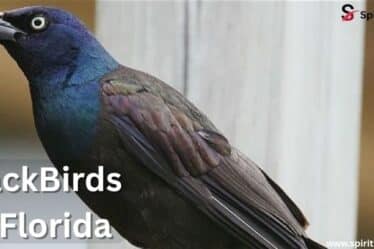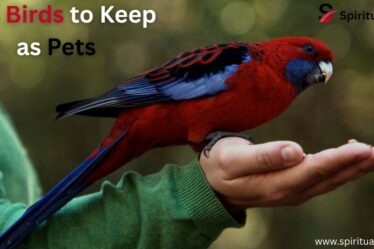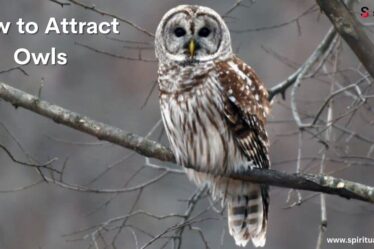
Bees love sweet things, and hummingbird feeders are full of sugar water. If you’re seeing swarms of bees instead of birds, you’re not alone. Many people struggle with how to keep bees away from hummingbird feeders. It can be frustrating when bees take over your backyard feeder, chasing away the hummingbirds.
Knowing how to keep bees away from hummingbird feeders helps protect the food meant for your birds. You don’t have to harm the bees—just move them along. This guide will show safe, easy ways to fix the problem. With the right tips, you’ll enjoy hummingbirds again without the buzz of bees nearby.
A Hummingbird Predator
While bees and hummingbirds aren’t natural enemies, bees behave like predators around feeders. Their aggressive and territorial behavior makes it difficult for birds to feed calmly. Bees often arrive in large numbers, following scent trails to the sugar. This leads to a nectar dearth for hummingbirds and an unpleasant backyard experience for humans. Sometimes, wasps and even ants join in, making the feeder completely unusable.
Hummingbirds need energy-rich food from nectar-rich flowers or sugar water, and when feeders are swarmed by bees, they lose access to vital nutrition. So, it’s not just about keeping bees away—it’s about protecting the health and happiness of your backyard hummingbirds.
1. Use a Red Hummingbird Feeder
Red feeders are a must when trying to figure out how to keep bees away from hummingbird feeders. As mentioned, bees and other insects are more attracted to the color yellow, so choosing a red design is an easy and effective fix. Look for feeders without any yellow on the feeding ports, perches, or decorative elements.
Some modern feeders are specifically designed to reduce insect problems. These designs not only avoid bee-attracting colors but also come with built-in ant moats, bee guards, or mesh barriers that keep insects out while still letting hummingbirds in.
2. Get Nectar Guards
Adding nectar guards to your feeder is another effective way to reduce bee visits. These small devices fit over the feeding ports and only allow birds with long beaks and tongues to access the nectar. Bees and wasps simply can’t reach it. Most nectar guards are made of flexible silicone and can be purchased separately or come built into newer feeders.
They create a physical barrier while keeping the feeder bird-friendly. Plus, they help reduce spilled nectar, which often leads to sugary residue—another big magnet for bees and ants.

3. Plug Leaks
Leaking feeders are a top reason for bee problems. Sticky sugar water dripping onto the outside of the feeder invites bees, ants, and other pests to the area. It also leaves a mess that attracts even more insects over time. Check your feeder regularly for cracks, loose parts, or poorly fitted components that can cause leaks.
Seal any leaks or consider upgrading to saucer feeders, which are less likely to leak because of their top-fill design. Reducing leaks also helps maintain the right sugar water mixture concentration ratio, keeping hummingbirds healthy and your yard less attractive to bees.
4. Stay in the Shade
Bees prefer warm, bright areas where they can easily see and access food. Placing your hummingbird feeder in a shaded area or under trees gives birds a cooler, quieter place to feed while making it harder for bees to find the feeder. Dappled shade or afternoon shade is ideal.
Not only does shade reduce bee traffic, but it also helps prevent the nectar from fermenting too quickly in hot sun. This keeps your sugar solution fresher longer and more appealing to hummingbirds.
5. Relocate Frequently
Bees have great memories and will return to a food source again and again. But if you relocate feeders or move feeders just a few feet every few days, it can confuse bees and disrupt their scent trails. Hummingbirds, on the other hand, are smarter navigators and will easily find the new location.
This method works best when combined with nectar guards, shade, and regular cleaning to make the area less attractive to pests overall.
6. Plant a Pollinator Garden
A smart way to reduce competition at feeders is to give bees their own space to enjoy. Creating a nectar garden full of pollinator-friendly flowers like bee balm, trumpet vine, cardinal flower, fuchsia, nicotiana, and nasturtiums will attract bees away from your hummingbird feeding station.
You can also include bird baths or alternative water sources nearby to support other wildlife and keep everyone happy. A dedicated space for bees creates a more peaceful atmosphere around your feeders and encourages balance between all pollinators.
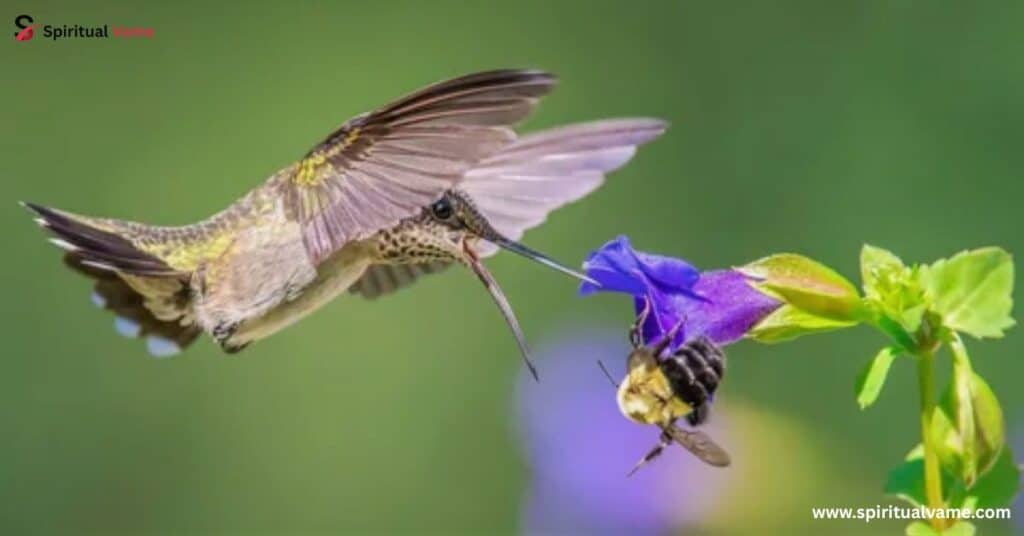
How to Keep Bees Away From Hummingbird Feeders Naturally
Natural methods are always the safest and most environmentally friendly way to solve feeder problems. If you’re trying to figure out how to keep bees away from hummingbird feeders without harming bees, hummingbirds, or other pollinators, these gentle techniques can help.
One great method is using saucer feeders instead of inverted bottle feeders. In a saucer feeder, the nectar sits deeper inside, out of reach for bees but still accessible to hummingbirds. They’re cleaner, less likely to leak, and easier to fill with the right sugar water concentration ratio, such as the common 1:4 ratio or 1:5 ratio used to make diluted nectar.
1. Choose a Saucer Type of Hummingbird Feeder
Saucer feeders are shallow and store nectar in the bottom dish rather than an upside-down bottle. Bees can’t reach the sugar water mixture ratio as easily, which keeps them away. These feeders also usually come with bee guards or nectar guards already built in. Their design helps reduce sugar water mixture concentration ratio from being exposed to air, reducing scent spread.
2. Provide Alternative Snack Selections for Honey Bees
Give bees a better place to go by offering a simple sugar solution station away from your main feeder. A shallow dish with diluted sugar water placed in a sunny spot can distract bees while leaving your hummingbird feeder bee-free. Make sure it’s far enough from the feeder, so bees don’t just switch back and forth.
3. Keep Your Hummingbird Feeder Clean
Cleaning feeders regularly removes sticky build-up and sugary residue that attracts insects. Use warm water, a gentle brush, and rinse thoroughly. Do this every few days, especially in warm weather. A clean feeder is safer and more inviting to hummingbirds.
4. Check Feeder for Leaks
Inspect your feeder weekly. Look for leaks, loose parts, or broken seals that allow nectar to escape. Fix these issues or consider buying feeders with better seals, like saucer feeders or those with built-in ant moats.
5. Avoid Feeders with Yellow Inserts
As mentioned earlier, yellow feeders or yellow parts draw bees in quickly. Switch to models with red-only designs and no yellow accents around the feeding ports or lids.
6. Hang the Hummingbird Feeder in the Shade
Keeping feeders in shaded areas reduces bee visibility and nectar evaporation. It also extends the freshness of your sugar water mixture concentration and makes the space more comfortable for hummingbirds.
7. Deter Unwanted Bees with Vinegar
A small amount of vinegar applied to the outside of the feeder or surrounding surface can mask the sweet smell of nectar. Bees dislike the scent, but it won’t harm them or hummingbirds. Don’t spray near the actual feeding ports.
8. Or Keep Bees Away with Citrus
Another smell bees dislike is citrus oil. You can place citrus peels near the feeder or use diluted citrus oil spray on the feeder’s exterior. It’s a natural way to create a bee-free zone.
9. Distract Bees With a Pollinator Garden
Bring bees to their favorite flowers by planting a garden filled with nectar-rich flowers. Keep it away from your feeders and include bee balm, fuchsia, and nasturtiums to keep bees happy and hummingbirds unbothered.
10. Install a Decoy Feeder
Try a decoy feeder filled with a sweeter sugar syrup—maybe with a 1:2 ratio—placed far from your main feeder. The bees will choose the easier meal and leave your hummingbirds in peace.
11. Try Essential Oils
Essential oils like peppermint oil and clove oil have strong scents that bees don’t like. Dab them around the base or top of your feeder, avoiding the ports. This discourages insects without bothering birds.
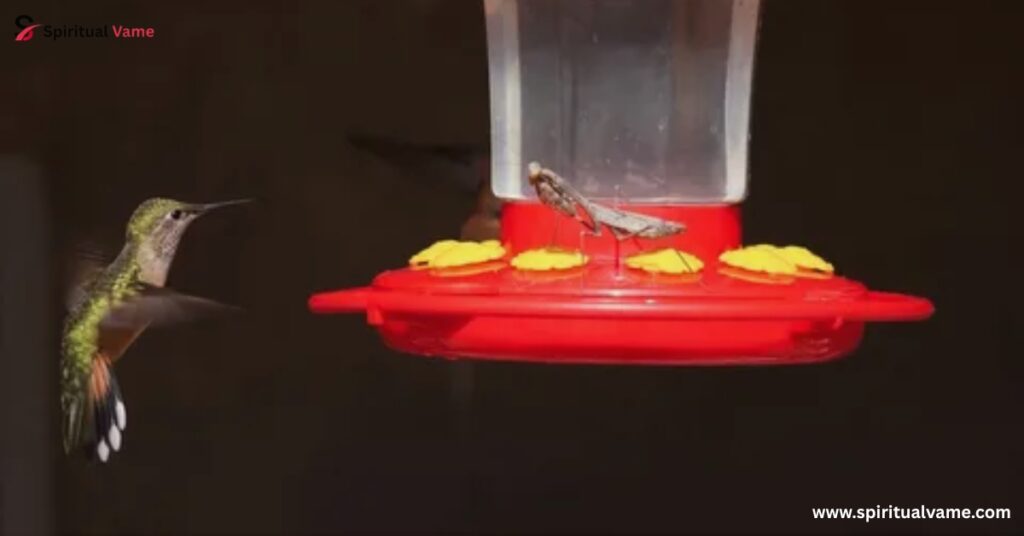
While it’s tempting to try quick fixes, some methods are harmful and should be avoided. They can damage your feeder, hurt wildlife, and even affect your health.
1. Don’t spray insecticides and pesticides
Using pesticides or sprays near feeders may kill bees, but it also risks poisoning hummingbirds and contaminating your garden. It disrupts natural ecosystems and harms helpful pollinators like butterflies and honey bees. Choose natural deterrents instead.
2. Don’t use petroleum jelly
Many people try to apply petroleum jelly around feeding ports to stop ants or bees, but this can coat the birds’ feathers or be accidentally ingested. It’s sticky, hard to clean, and doesn’t actually keep insects away for long.
Keep Bees and Wasps Away with Saucer Feeders
Choose feeders that keep the sugar water mixture concentration ratio deep inside the base. Bees can’t reach the nectar, but hummingbirds can easily drink through long beaks.
Attach an Ant Moat to Hummingbird Feeders
Ant moats filled with water or vinegar act as a barrier that crawling insects like ants can’t cross. Many feeders come with built-in ant moats, or you can buy one separately.
Hang Hummingbird Feeders with Fishing Line
Fishing line is smooth and hard for crawling insects to grip. It also helps reduce wasp access and blends in nicely with the background.
Slip Nectar Guard Tips Over Hummingbird Feeder Holes
These small silicone covers make it nearly impossible for bees to feed. But hummingbirds can still enjoy the nectar through their long beaks and tongues.
Periodically Move Feeders
Changing the feeder’s location breaks scent trails and confuses bees. Move it every few days to stay one step ahead of the swarm.
Place Fake Wasp Nests Nearby
Wasps are territorial and won’t approach another nest. Hanging a fake wasp nest nearby tricks them into leaving the area alone.
Plant Bee- and Hummingbird-Friendly Flowers
Give each group its own space by planting flowers like trumpet vine, cardinal flower, and fuchsia in one part of the yard. It brings harmony and keeps feeders bird-focused.
Keep Your Sugar Water Mixture Simple and Safe
One of the most important factors in keeping bees away is getting the sugar water concentration ratio just right. Hummingbirds prefer a 1:4 ratio—that means one part white sugar to four parts water. This mix mimics the natural sweetness of flower nectar. Bees, however, prefer a more concentrated solution like a 1:2 ratio, which is much sweeter and more appealing to them. So, if your nectar is too strong, you could be unknowingly inviting bees to your hummingbird feeders.
Avoid using honey, brown sugar, or artificial sweeteners, as these can harm hummingbirds and attract even more pests. Stick with plain white sugar and always boil the water first, then let it cool before filling your feeder. Keeping your sugar water solution concentration consistent and safe helps your hummingbirds thrive while making the area less interesting for bees.
Maintain a Bee-Free Feeding Experience for Hummingbirds
In the end, knowing how to keep bees away from hummingbird feeders comes down to balance. You’re not trying to harm bees—just give your hummingbirds a quiet, safe place to feed. By using nectar guards, choosing saucer feeders, cleaning regularly, and planting a separate nectar garden, you support both pollinators and birds. Every detail—from sugar water mixture concentration ratio to feeder placement—affects how many insects show up.
Don’t forget, small changes go a long way. Moving feeders now and then, avoiding yellow feeders, using natural scents like peppermint oil, and hanging a fake wasp nest can all make a big difference. With a little effort, your backyard can become a peaceful oasis filled with the flutter of wings and free from unwanted buzzing.
Conclusion
Keeping bees away from hummingbird feeders requires a thoughtful approach that balances both attracting hummingbirds and deterring pests. By adjusting the sugar water ratio, using nectar guards, and strategically placing your feeders in shaded areas, you can create an inviting and peaceful feeding station for the birds while keeping bees, wasps, and ants at bay. Additionally, planting a nectar garden with pollinator-friendly flowers like bee balm and trumpet vine will give your pollinators their own space to thrive.
With the right care and attention to detail, such as regular cleaning, moving feeders, and using natural repellents like peppermint oil or fake wasp nests, you can enjoy the beauty of hummingbirds without the disruption of bees. By taking these steps, your backyard will become a peaceful haven for both hummingbirds and other pollinators, creating a balanced and harmonious environment for all.

